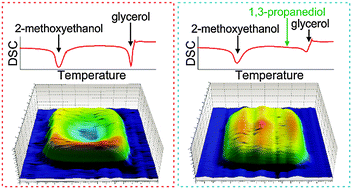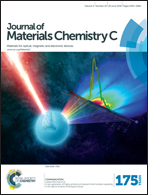Inkjet printing of uniform dielectric oxide structures from sol–gel inks by adjusting the solvent composition
Abstract
We present a study of the inkjet printing of tantalum-oxide-based dielectric structures on indium-tin-oxide-coated glass. Ta-Al-Si-alkoxide-based ink formulations with 2-methoxyethanol (2MOE) as the main solvent and a highly viscous glycerol (GLY) or 1,3-propanediol (PD) co-solvent exhibit the optimal values of viscosity and surface tension for piezoelectric inkjet printing, and show good jetting performance. However, the drying of the printed structures results in a pronounced “coffee-stain” effect. We relate this phenomenon to the much higher volatility of 2MOE than either of the viscous solvents and the dominant evaporation of the former immediately after the ink has been printed on the substrate. Consequently, the recirculating Marangoni solvent flow exists only at the onset of drying and ceases to exist once the 2MOE has completely evaporated from the drying feature. The combination of all three solvents appears to prolong the duration of the Marangoni flow, as suggested by differential scanning calorimetry, resulting in an improved uniformity of dried structures. By adjusting the solvent composition we could tailor the topology of deposits and print 45 nm-thick, flat and uniform capacitors with the performance (good dielectric properties of εr ∼ 15, tan(δ) ∼ 0.034 at 100 kHz and a low leakage current density of 2.4 × 10−7 A cm−2 at 200 kV cm−1) comparable to spin-coated films.



 Please wait while we load your content...
Please wait while we load your content...